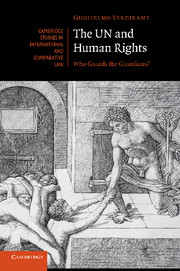Book contents
- Frontmatter
- Contents
- Foreword
- Acknowledgements
- Abbreviations
- Table of cases (international)
- Table of cases (national)
- Table of legal instruments
- Introduction
- 1 Concepts and definitions
- 2 Human rights obligations of international organisations
- 3 International institutional responsibility
- 4 UN relief and development operations
- 5 UN peacekeeping operations
- 6 International administrations
- 7 Implementation of UN sanctions
- 8 Accountability
- Conclusions
- Bibliography
- Index
- References
6 - International administrations
Published online by Cambridge University Press: 07 October 2011
- Frontmatter
- Contents
- Foreword
- Acknowledgements
- Abbreviations
- Table of cases (international)
- Table of cases (national)
- Table of legal instruments
- Introduction
- 1 Concepts and definitions
- 2 Human rights obligations of international organisations
- 3 International institutional responsibility
- 4 UN relief and development operations
- 5 UN peacekeeping operations
- 6 International administrations
- 7 Implementation of UN sanctions
- 8 Accountability
- Conclusions
- Bibliography
- Index
- References
Summary
Introduction
It is axiomatic that authorities that exercise effective control over an inhabited territory have the functional capacity – the power, but not the right – to violate human rights. When the UN, which is no exception to this axiom, exercises territorial control, it normally does so on the basis of an express mandate contained in a resolution of the Security Council, in a treaty, or both; but there are also situations, most notably refugee camps, in which the UN controls an inhabited territory in the absence of such an express mandate, that is on a de facto basis.
Those in effective control of territory may be assimilated to ‘public officials or other persons acting in an official capacity’ for the purposes of the definition of torture and other human rights (see Article 1 of the Convention Against Torture and Other Cruel, Inhuman or Degrading Treatment or Punishment). The Committee Against Torture noted that ‘for some years Somalia has been without a central government’ and that some ‘factions operating in Mogadishu … have set up quasi-governmental institutions and are negotiating the establishment of a common administration. It follows then that, de facto, those factions exercise certain prerogatives that are comparable to those normally exercised by legitimate governments’. For a narrower view with respect to the risk posed ‘by a non-governmental entity’, see GRB v Sweden (15 May 1998) CAT/C/20/D/083/1997 (at para. 6.5), where the Committee considered the risk of rape or torture from the Shining Path (Sendero Luminoso) in Peru) to fall outside of Article 3 of the Convention.
International administrations of territory by a group of states, rather than by an international organisation, were instituted in the nineteenth century, the leading examples being the Free City of Cracow (1815–46), the City of Shanghai (1845–1944) and the Island of Crete (1897–1909). The administration of the Saarland by the League of Nations after the First World War was the first instance of an international organisation ruling over a territory. The League of Nations also had an administrative role in the City of Danzig under the terms of the Treaty of Versailles, but on a more limited basis than in Saarland. The resident High Commissioner of the League in Danzig acted as court of first instance in disputes between Poland and Danzig, while appeals were considered by the Council of the League, which could in turn request an advisory opinion from the Permanent Court of International Justice. In the aftermath of the Second World War, the UN drew up plans for various international administrations, for example in the Free City of Trieste and in Jerusalem, but none was implemented until the international administration of West New Guinea (West Irian) in 1962–3 following an agreement between Indonesia and the Netherlands. Since the end of the cold war, international administrations have been set up in various places, including Cambodia, Bosnia and Herzegovina, Eastern Slavonia, East Timor and Kosovo.
- Type
- Chapter
- Information
- The UN and Human RightsWho Guards the Guardians?, pp. 230 - 299Publisher: Cambridge University PressPrint publication year: 2011



